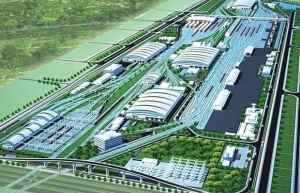World Bank forecasts Vietnam’s economy to grow by 6.1 per cent in 2024
 |
The report pointed out that Vietnam’s GDP grew by 6.4 per cent on-year in the first half of 2024 after a moderate 5 per cent growth in 2023, boosted by a rebound in manufacturing exports as well as higher consumption and investment.
Merchandise trade was more robust than expected in the first half of 2024, fuelled by stronger external demand, with exports and imports growing at 16.9 and 17 per cent on-year, respectively. While the net export contribution to GDP remains modest, expanding trade was accompanied by a gradual recovery of domestic demand, with investment and consumption growth recording 6.7 and 5.8 per cent on-year, respectively.
The projection of Vietnam's economic growth assumes an easing of manufacturing exports growth in the second quarter of 2024 and the expected moderation of global demand, in the US in particular, Vietnam’s largest export market.
The real estate market is showing signs of a recovery and is forecast to turn the corner in late 2024 and into 2025 as the corporate bond market freeze has eased and the Land Law came into effect from August. With continued export growth and signs of a real estate recovery, domestic demand is set to firm up in the second half of the year as investor and consumer sentiment improve. The current account balance is projected to retain a small surplus, while the government resumes fiscal consolidation, and projected inflation slows from 4.5 per cent in 2024 to 3.5 per cent in 2026.
"Given the economy is not yet back to its pre-pandemic growth path, accelerating disbursement of public investment would support aggregate demand in the short run, while also helping to close emerging infrastructure gaps. An increase in public investment by one percentage point of GDP could lead to a rise in GDP of 0.1 per cent. On the other hand, monetary authorities continue to face limited room for additional interest rate cuts due to existing large interest rate differentials between domestic and international markets and the pressure it could bear on the exchange rate," said the World Bank in its report.
Building on recent reforms, further steps to mitigate financial sector risks and vulnerabilities remain crucial. The World Bank proposes authorities encourage banks to improve capital adequacy ratios and strengthen the institutional framework for prudential supervision (including to detect and address issues arising from the affiliation of banks with business groups) and early interventions (early identification of problems and prevention of fully blown crises).
While the Law on Credit Institutions was enhanced with a recent amendment, gaps remain in some areas, including consolidated supervision on a group basis, particularly of banks affiliated with the real estate sector. Other areas for improvement include bank resolution and crisis management, as well as legal protection of supervisors. For example, the State Bank of Vietnam (SBV) does not have a full range of resolution powers and tools to deal with non-viable banks.
Strengthening the SBV’s mandate in these areas should be a priority in upcoming financial sector legal reforms, including through amendment of the Law on the State Bank of Vietnam.
 | Hanoi to ask for WB’s help with design of national railway station The Hanoi Department of Transport has proposed the municipal People’s Committee ask for the World Bank (WB)’s assistance in the technical design of the general layout for the Ngoc Hoi national railway station complex. |
 | PM receives outgoing WB Country Director Prime Minister Pham Minh Chinh on March 28 hosted a reception for World Bank (WB) Country Director for Vietnam Carolyn Turk, who came to say goodbye at the end of her tenure. |
 | Key driver gains a must for growth Only slight order number improvements and enterprise confidence sentiment mean it may be difficult for the country to hit its desired growth goals this year. |
What the stars mean:
★ Poor ★ ★ Promising ★★★ Good ★★★★ Very good ★★★★★ Exceptional
 Tag:
Tag:
Related Contents
Latest News
More News
- Businesses ramp up production as year-end orders surge (December 30, 2025 | 10:05)
- Vietjet chairwoman awarded Labour Hero title (December 29, 2025 | 13:06)
- How to unlock ESG value through green innovation (December 29, 2025 | 10:03)
- AI reshapes media and advertising industry (December 29, 2025 | 08:33)
- FPT and GELEX sign deal to develop blockchain tech for global markets (December 29, 2025 | 08:29)
- Vietnam’s GDP forecast to grow by 9 per cent in 2026 (December 29, 2025 | 08:29)
- Women entrepreneurs are key to Vietnam’s economic growth (December 29, 2025 | 08:00)
- Vietnam's top 500 value-creating enterprises announced (December 27, 2025 | 08:00)
- The PAN Group shaping a better future with ESG strategy (December 26, 2025 | 09:00)
- Masan Consumer officially lists on HSX, marking the next phase of value creation (December 25, 2025 | 13:20)























 Mobile Version
Mobile Version